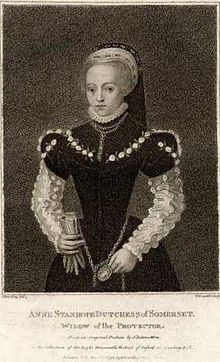"Lord Hertford" redirects here, for other persons holding that title see Marquess of Hertford
Edward Seymour, 1st Earl of Hertford, 1st Baron Beauchamp, KG (22 May 1539 â€" 6 April 1621) was the eldest son of Edward Seymour, 1st Duke of Somerset, by his second wife Anne Stanhope. He is most noted for incurring the displeasure of Queen Elizabeth by more than one clandestine marriage.
Early life
.jpg/220px-Edward_Seymour,_Earl_of_Hertford,_Attributed_to_Hans_Eworth_(1515_-_1574).jpg)
From 1547, when his father was created Duke of Somerset, his son Edward Seymour was styled by the duke's subsidiary title of Earl of Hertford. He was educated with the young Prince Edward, later Edward VI, and was knighted on the occasion of Edward's coronation. On 7 April 1550 he was sent to France as a hostage, returning three weeks later. Following his father's disgrace and execution, his son was barred from inheriting his titles and most of his wealth. Some of his father's lands and property were restored to him by Edward VI, but he still seemed to have been forced to rely on Sir John Thynne for some financial support. Under Queen Mary he was "restored in blood", but was not given back his title; Queen Elizabeth I created him Earl of Hertford, in the earldom's second creation, in 1559.
A series of clandestine marriages

Catherine Grey
His first wife, Lady Catherine Grey, was a potential claimant to Elizabeth's throne, and law established that it was a penal offence for her to marry without notifying the Sovereign. They were married by an anonymous clergyman at Hertford House, Canon Row, before 25 December 1560. The marriage was kept secret until August nearly a year later when Catherine became visibly pregnant and she confided the reason to Lord Robert Dudley. Each was ordered to confinement in the Tower; Catherine was confined immediately, and Seymour imprisoned upon his return. While in custody, they were questioned about every aspect of their marriage, but they both claimed to have forgotten the date.
A commission was begun, headed by Archbishop Parker in February 1562. Under this pressure, Lady Catherine finally declared that they had waited for Elizabeth to quit the capital for Eltham Palace. Servants were questioned, and none of them could remember the exact date either. John Fortescue said it was 'in November'. The priest could not be located, but by consulting the accounts of the Cofferer of the Household the marriage date was decided to be 27 November.
His son Edward was declared illegitimate and the father was fined 15,000Â pounds in Star Chamber for "seducing a virgin of the blood royal."
Despite all this, the Earl apparently found a way to continue marital relations with his wife in the Tower. In February 1563, Thomas Seymour was born. Lady Catherine died in 1568, and Seymour was finally allowed out of the Tower and allowed to re-appear at court. Officially his sons remained bastards. In 1576 he carried the sword of state at Elizabeth's procession of the knights of the garter.
His eldest son was Edward Seymour, Viscount Beauchamp (1561â€"1612) whose son William Seymour, 2nd Duke of Somerset was imprisoned for secretly marrying Arbella Stuart. In fact, Edward, William, and William's elder brother, another Edward, were all, at various times, considered possible matches for Arbella. Among his descendants was Elizabeth Bowes-Lyon, mother of Queen Elizabeth II.
Frances Howard
In 1582, he married his second wife, Frances Howard. Their union was in secret, and remained a secret for nearly a decade, with Frances serving as a gentlewoman of the Privy Chamber. Hertford attempted to have this marriage set aside in 1595 (hoping to clear his still illegitimate sons' claim to the throne). He was arrested again, and Frances died in 1598.
Frances Pennell
In May 1601, he secretly married once more, to the wealthy widow Frances Prannell, also born Frances Howard, the daughter of Thomas Howard, 1st Viscount Howard of Bindon. The marriage was performed by Thomas Montfort without banns or license, for which Monfort was suspended for three years by Archbishop John Whitgift.
Ancestry

Notes

References
,_Attributed_to_Gilbert_Jackson_(1622_-_1640).jpg/220px-William_Seymour,_Marquess_of_Hertford,_later_Duke_of_Somerset_(1588-1660),_Attributed_to_Gilbert_Jackson_(1622_-_1640).jpg)
-  "Seymour, Edward (1539?-1621)". Dictionary of National Biography. London: Smith, Elder & Co. 1885â€"1900.Â
- Haynes, Alan. Sex in Elizabethan England. Gloucestershire: Sutton Publishing Limited, 1997. ISBN 0-905778-35-9
- The Earl of Hertford's Lieutenancy Papers, 1603-1612, ed. W. P. D. Murphy, (Wiltshire Record Society vol. 23, 1969)

